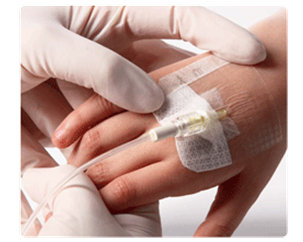Code: 4007
PIP Code: 238-0269
Pack Qty: 100
Nothing keeps an IV site dry like IV3000
"A warm moist environment, conducive to a high microbial bioburden, [may] increase the risk of infection" 1
Catheter-related infections are a serious barrier to healing, keeping patients in hospital longer and increasing the cost of care. Semi-permeable film dressings stop most bacteria getting into the IV sites but they also trap moisture, making it easier for the bacteria that do get in to reproduce. 2
IV3000 has been specifically designed for IV sites, with its REACTIC◊ film and unique grid pattern adhesive allowing optimum moisture vapour transfer to reduce moisture build-up and bacterial growth. 3
IV3000 offers a moisture vapour transmission rate over FIVE TIMES that of its nearest competitor, helping to keep moisture levels under the dressing to a minimum. 4-7
Giving more to you and your patients
For you
- Ward educational packages and animated tools to make application training straightforward
- Support from clinical specialists to answer complex questions on IV site care
- Visual infusion phlebitis scoring tools to help you spot inflamed blood vessels before they become a problem
For your patients
- IV3000 dressings are waterproof so patients needn't remove them every time they want a shower 5
- Our low allergy, non-irritating adhesive is easy to remove, allowing greater patient comfort 16,17
- Long-lasting dressings mean fewer uncomfortable dressing changes 18
An IV-site that protects your budget too
Catheter-related bloodstream infections cost around £6,000 per infection to treat. 13
Reducing bacterial propagation near the IV site is one way of reducing this risk. 8 Another way is to limit exposure of the IV site to the surrounding environment.
IV3000 dressings can be kept in place for up to seven days, meaning fewer dressing changes and less chance of bacterial infection. 19
This also:
- creates less need for dressing changes, reducing nursing time
- minimises potential for catheter dislodgement, which can help avoid the extra expense of recannulating a patient




